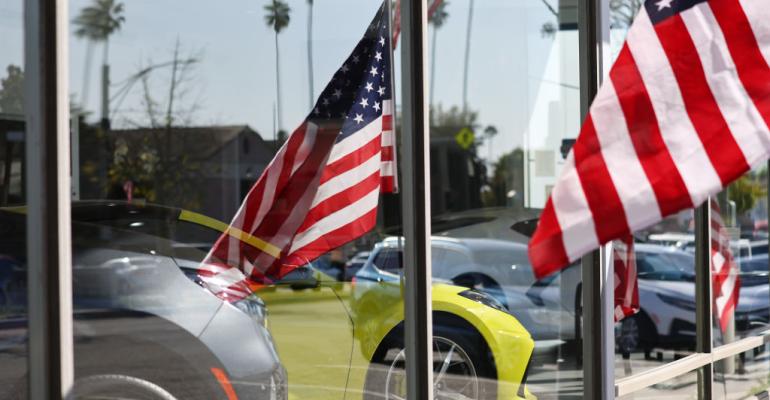NEW YORK – It will be another year of tight inventories, supply chain disruptions and relatively low production. Yet, 2023 is on track to becoming the second most-profitable year on record for both automakers and dealers in the U.S., an industry analyst says.
It follows the most profitable year, 2022.
Thomas King, president of the analytics division at J.D. Power, one of the hosts of the Automotive Forum at the recent auto show here, expects light-vehicle sales in the U.S. to grow to 15 million units in 2023, up nearly 10% after two years below 14 million units, but still lagging pre-COVID highs of 16.7 million in 2019 and 17.2 million in 2018.
Retail and fleet sales are included in the 2022 total and 2023 forecast, with retail accounting for the dominant share.
“2022 was pretty remarkable,” says King (pictured, below left). “Although sales were 15% below 2019 levels, demand exceeded supply and transaction prices were the highest ever, while vehicles were sold with minimal discounts.
 “The value of new vehicles purchased also set in a record during the year, $532 billion, while at the retailer level, profit per unit was a hair under $5,000, hands-down the most profitable year ever,” he adds.
“The value of new vehicles purchased also set in a record during the year, $532 billion, while at the retailer level, profit per unit was a hair under $5,000, hands-down the most profitable year ever,” he adds.
Retailer profits grew to $55 billion, according to King.
The J.D. Power executive expects profits to fall to between $28 billion and $37 billion in 2023 but still substantially above pre-COVID levels.
“There’s still considerable pent-up demand,” he says. “If COVID hadn’t happened, we would’ve sold about 7 million more units over the past three years. Some of those deals are gone and lost forever, but 2.4 million still remain to be delivered if the price is right.
“To the extent the industry can make these vehicles available, we have a workable tailwind in 2023 comprising access to this unmet demand.”
While inventories have improved from 800,000 units a year ago to 1.3 million today, King notes those 1.3 million units compare with 3.0 million units in March 2020.
He further reports that dealer profits, estimated at $3,700 per car in March, are more than double what they were three years ago, while manufacturer incentives, at 3.3%, up from 2.0% in September, are still nearly 70% below March 2020 levels.
New-car profit margins were 5.1% in March, compared with 7.7% a year ago and 0.6% in March 2020.
Against this backdrop, trade-in value, at an average of $8,800, is still near record highs.
Meanwhile, John Murphy, lead U.S. auto analyst at Bank of America Merrill Lynch, told attendees that the record market in 2022 was followed by a record first quarter in 2023.
Murphy, joined by Bloomberg Intelligence senior analyst Kevin Tynan in a panel discussion, says: “The impetus to drive to lower price points is not there. In the near term, we’re going to see higher prices because manufacturers are making a lot of money, which eventually will be needed for electric-vehicle development.”
Adds Tynan: “Those entry, move-up vehicles do not exist. They’re not in the portfolio anymore. There’s nothing to shift downmarket to.”
In practical terms, the way this works can be seen in how American manufacturers, in particular, are addressing shortages of semiconductors.

Microchip shortage that depressed dealer inventories in 2021 persists.
“We have an industry where there’s a finite amount of chips, a chip shortage,” says Tynan. “I’m going to put them in my Ford F-150s and my fullsize SUVs. I’m not going to put them in my entry and move-up vehicles.
“If we look at 2016 when light vehicle sales peaked at 17.5 million units, the average transaction price was around $35,000, with discounts and incentives of 6.5% and 10%, respectively,” Tynan says. “Compare that with this year’s 15 million-unit market and a $48,000 or $49,000 average transaction price. This market is far bigger than it’s ever been.”
Murphy and Tynan both take aim at Tesla, the world’s largest EV manufacturer, which in 2022 sold 1.3 million units globally and 536,000 in the U.S., both record highs.
 “As an old-school car guy, I don’t get it,” says Tynan (pictured, left). “Are there competitive advantages for that company? Yes. Its charging network may be one of them. But at the end of the day the company sold 1.3 million units globally last year and is worth three times what Toyota is worth. I’ll never understand that.”
“As an old-school car guy, I don’t get it,” says Tynan (pictured, left). “Are there competitive advantages for that company? Yes. Its charging network may be one of them. But at the end of the day the company sold 1.3 million units globally last year and is worth three times what Toyota is worth. I’ll never understand that.”
(On April 10, Tesla’s market capitalization stood at $587.8 billion; Toyota’s was at $187.4 billion. Toyota still ranks second in the industry.)
Tynan believes that “If Toyota, BMW, Ford or GM committed fully to electrification” – Tesla launched the Model S in 2012 – “it wouldn’t take them 10 years to get to 1.3 million units. It probably wouldn’t take them 10 quarters.”
He concedes that many consumers see Tesla as a technology company and that owning a Tesla is a sort of fashion statement. “Still,” he says, “I don’t know how Tesla’s stretch target of 20 million units by 2030 is realistic.”





